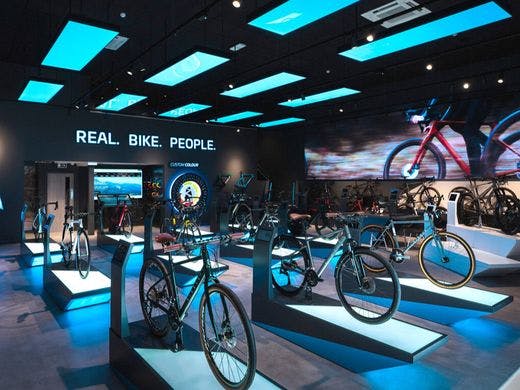The modern consumer wants convenience and choice – both fundamental features of digitally native brands, which is why our portfolio often starts out as a D2C or ecomm business. When done well, it can be the most cost-efficient way to start and grow a retail business or brand. But as inflation bites and consumer confidence takes a tumble, retailers and brands are rightly concerned about the months ahead, and what the future strategy should be.
While there isn’t a silver bullet for retailers and brands to navigate this tough time and beyond, what we have at True is real operational experience, where we’ve tried and tested different strategies with our brands.
The highstreet has seen a lot of change with larger retailers such as Debenhams and House of Fraser disappearing from town centres, making it appear that bricks and mortar is not what it once was. We know that not all businesses benefit from physical space, given the cost of commercial real estate, business rates and typically long-term lease commitment in the UK, but it’s an important part of the omnichannel mix. When we first partnered with Ribble Cycles (2015) and The Cotswold Company (2016) we knew there was a significant opportunity to enhance the offering and customer journey with the strategic placement of showrooms, especially given the high price point of products which really benefit from being touched, felt and trialled by shoppers.
With five showrooms across the country, Ribble has consolidated most of what it has learnt to date in its flagship showroom in Clitheroe, which opened in 2021. It is not only located close to Ribble HQ and the birthplace of the brand but more importantly it’s placed in the cyclist mecca of the Ribble Valley so the town is a destination for its target consumers.
Here are three takeaways to help share what we’ve learnt from our showrooming strategies with our portfolio.
Location, location, location
New locations for The Cotswold Company are typically chosen through deep data-analysis, identifying target demographics, customer hotspots, halo analysis and drive-time analysis. The team also does a comparison of characteristics with the current showrooms already trading – and making sure there is a large enough distance between sites too, so the stores are destinations and ensure one store does not cannibalise the other. Notably, many of the sites that The Cotswold Company are in, feature unique architectural elements, making them memorable and embedding Cotswold’s brand externally as well as internally. For example, in Godalming the store is in a specially converted church, meanwhile its recently opened Tunbridge Wells’ store is in one of the town’s historic buildings.
“Ribble is constantly reviewing the performance of its showrooms and due to being a digitally native and destinational brand with a considered product offering pays particular attention to their true incrementality and ultimately actual ROI, because new locations are huge investments and customer behaviour, as we are aware, always continues to evolve.” Andy Smallwood, CEO, Ribble Cycles
Technology & innovation
Tech is a very strong consideration for Ribble customers, so it is not only fitting but also a major part of the customer experience to integrate purposeful retail innovations where possible. For example, the flagship Clitheroe showroom has Europe’s largest 4k screen to display the bikes in action while dedicated product information is contained on digital touch screen displays beside every bike. Ribble’s physical retail experience is a genuine extension of and complimentary to its digital experience.
Ribble and The Cotswold Company also use Emplifi video technology (Go InStore) to bring online customers into the showroom. It’s a one-way video call between a showroom team member and a customer that can help answer an online customer’s questions and show them elements of products that may be harder to show on the website, personalising the online experience. It also means with everyone in one enabled environment store staff can provide their full attention to customers. Ribble has found real success with this approach:
"When someone interacts with our video experience and connects with our showrooms, chats with our agents - their likelihood to go on to convert is nineteen times higher than we see from just normal browsers of our website...." Matthew Lawson CDO Ribble Cycles.
This is why True suggested The Cotswold Company might also want to trial the same technology. Not only did this help support both businesses through lockdowns, as people social distanced but the technology has continued to enhance the service you get with instore to create a seamless omnichannel experience.
Ribble has also made use of smart footfall-counter, Hoxton AI, which is one of True’s early-stage investments. The technology builds data over time to help staff distribution and scheduling, inventory management.
People & experience
Ribble and The Cotswold Company’s products are typically big-ticket items. These can be emotional purchases that people often spend a lot of time choosing and saving for, so salespeople must be tuned into that and well informed about all items to help the customer make the choice that is best for them.
Ribble has found the experiential approach works well for their brand and product category. The Clitheroe showroom has become the central point for a programme of events, such as ride-outs where customers can interact with the products and try different models out helping to build the community and brand loyalty.
What has True learnt
Every customer wants to engage differently with a brand, so choice and agility is key across all strategies. Visiting the shops in person is no longer a necessity, so we continue to hunt for dynamite tech through our innovation team which we can introduce to our partners and portfolio alike; finding solutions that will enhance the instore experience to make it both memorable and frictionless for customers but also ensure a showroom is a strong, strategic commercial decision.
